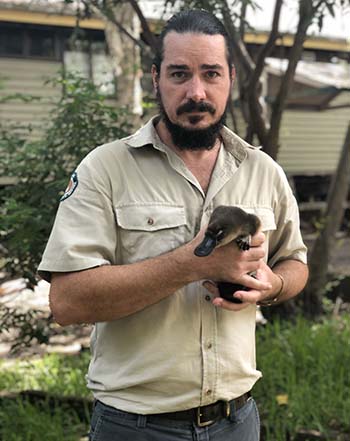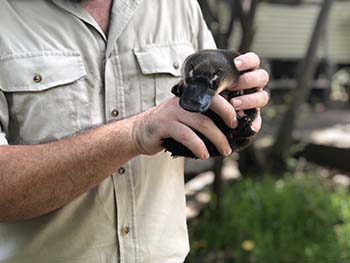
Ranger in Charge Jason Flesser with Jarrah the juvenile platypus.

Jarrah the juvenile platypus
Queensland rangers are caring for a young platypus, otherwise affectionately known as a puggle, after it was found severely dehydrated and covered with ticks under a house just over the border of the Gold Coast's hinterland.
Jarrah, the juvenile platypus, was taken to Currumbin Wildlife Hospital where he underwent initial health assessments and had all the ticks removed.
Jarrah was then placed in the care of Queensland Parks and Wildlife Services' Gateway Visitor Centre rangers. He is currently in a customised platypus enclosure where rangers are feeding him a variety of native diet that mimics the natural food of a platypus in the wild.
The tiny monotreme is receiving no less than the royal treatment, with a team of rangers and vets keeping a close watch. Ranger in Charge Jason Flesser said it was important to monitor Jarrah's progress, to ensure his health continues to improve.
"Rangers, in close consultation with their vet, are closely monitoring Jarrah to ensure he has the best chance of returning to the wild. Thankfully, he's been doing exceedingly well – gaining 62 grams in the first week of care at the Walkabout Creek Discovery Centre – and he continues to gain weight at a healthy rate," Mr Flesser said.
"Our team of professionals at the centre estimate Jarrah is around eight months old. He is what we call a 'dispersing juvenile' male platypus. When a male platypus is around seven to eight months old, they leave the care of their mothers to search for a water body of their own, to establish their own territory or home range.
"We understand Jarrah might have been looking for a place of his own when it is likely he's run into a little trouble. Thankfully, with the help of our team here at the Walkabout Creek Discovery Centre, Jarrah will have a better shot at his next burrow-hunting mission."
The Department of Environment and Science (DES) has a vast network of wildlife officers and rangers who regularly observe platypus in the wild, particularly around areas such as Eungella National Park west of Mackay. However, they can be found in rivers east of the Great Dividing Range, some western-flowing streams, and Tasmania.
The male platypus has a sharp spur on each ankle. These spurs are connected to a venom gland in each thigh. The venom glands are most active during the spring breeding season, so competing males probably use the spurs in territorial fights.
At around eight months old, Jarrah's spurs are still developing so there is no venom present yet.
Mr Flesser said it was a rare sight to see a young platypus up close.
"Platypus are elusive but, if you're lucky, you might see one at Girraween National Park in south Queensland, or Eungella National Park and Carnarvon National Park in central Queensland," he said.
"Platypus have sensitive hearing and are easily disturbed which is what makes them hard to spot at times. But that's what makes caring for Jarrah so special, because you rarely get to see a young platypus up close.
Mr Flesser said Walkabout Creek Discovery Centre was an excellent example of a Gateway Visitor Centre just 12 kilometres from Brisbane city run by the Queensland Government.
"It's right on the doorstep of Brisbane's closest national park – D'Aguilar National Park – with its diverse and beautifully unique Queensland flora and fauna," he said.
"Our Park Rangers at the Information Centre are ready to share their stories and help people discover all the special, nature-based experiences available.
"We have two Gateway Centres – David Fleay Wildlife Park on the Gold Coast, the legacy of Dr David Fleay who was the first to breed the Platypus in captivity, and Walkabout Creek Discovery Centre here at Enoggera Reservoir. Visitors are able to see many of our unique Queensland native animals or enjoy daily feedings and wildlife shows."
Walkabout Creek Discovery Centre's wildlife centre will close temporarily this week as the department invests further capital funds to upgrade the visitor centre deck. The new deck will be completed late May and visitors will once again be able to enjoy close encounters of the wild kind.
"While the centre is closed to visitors, animals like Jarrah will be right here on-site, enjoying some downtime," Mr Flesser said.
DES advises the public to not disturb platypus living in streams on people's properties or in the neighbourhood.
You can help the platypus living in your area by keeping natural plants along watercourses. If you do this, you will protect banks and will provide areas for the platypus to live.






